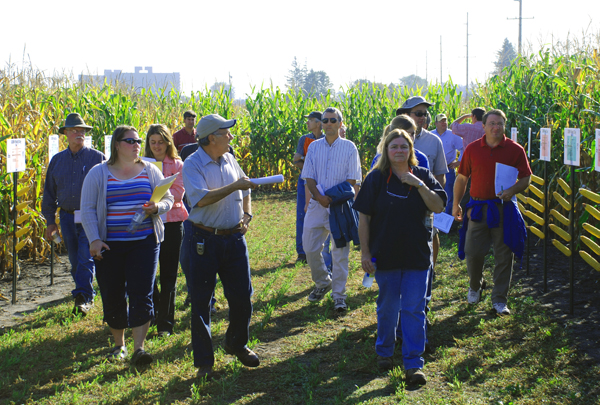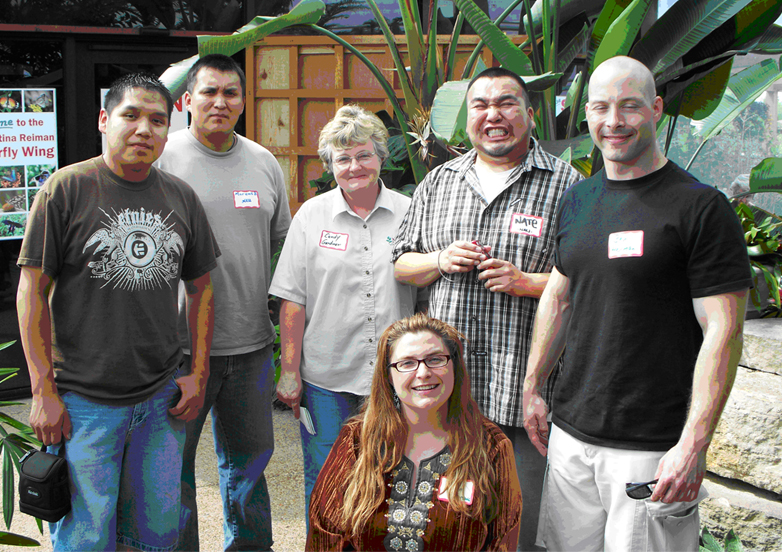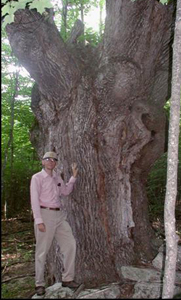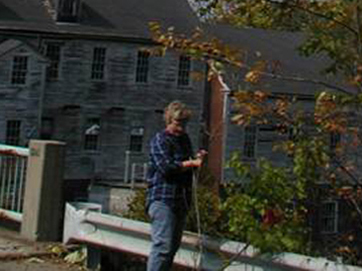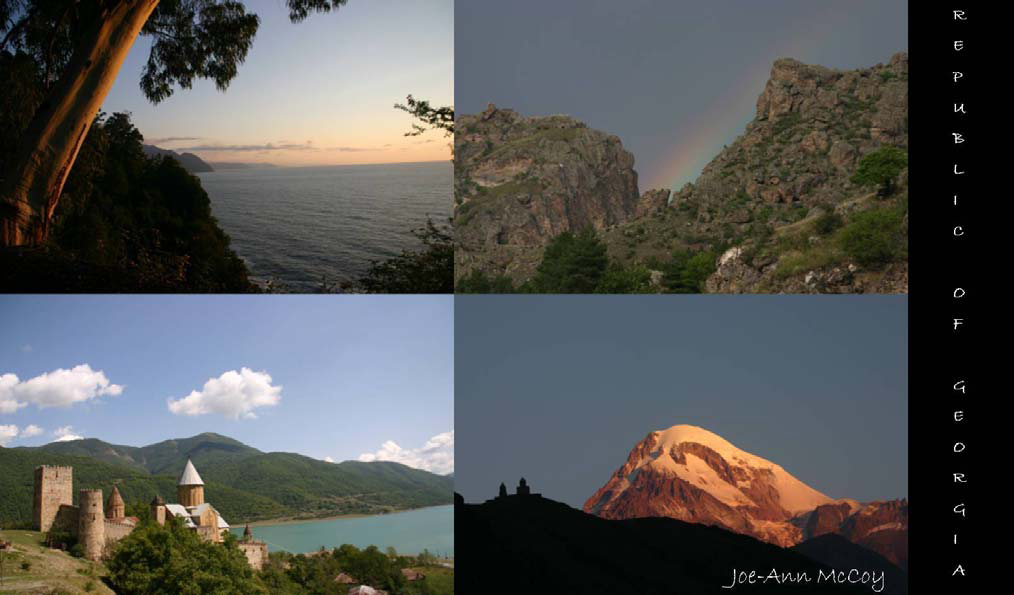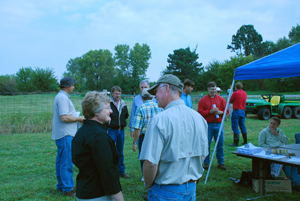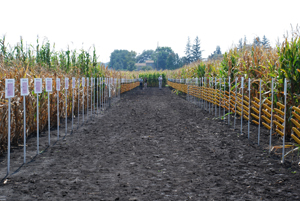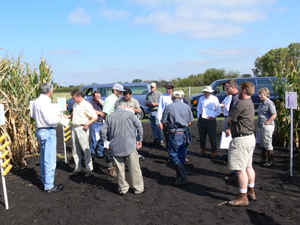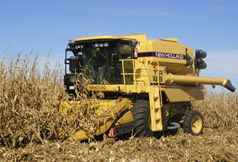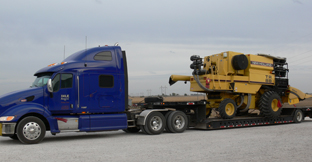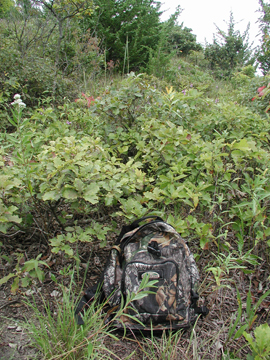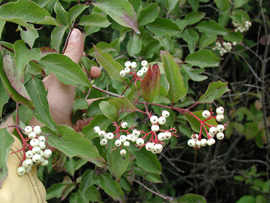| Archived News |

|
|
1 - News, Events, and Station Information
2 - Archived News |

Archived News Items:1. VEISHEA, 2009
2. Ash Germplasm Collection Trip, 2008
3. Germplasm Enhancement of Maize Field Day 2008
4. Plant Genome Outreach to Native Americans 2008
5. Ash Germplasm Collection Trip, 2007
6. Georgian Germplasm Collection Trip, 2007
7. Germplasm Enhancement of Maize Field Day 2007
8. Plant Genome Outreach to Native Americans 2007
9. Marek - Gulya - Seiler Collection Trip
10. Carsten - Hendrickson Collection Trip
11. Plant Genome Outreach to Native Americans 2006
NCRPIS Participates in 2009 VEISHEA Celebration
On Saturday April 18, 2009 over 500 guests visited the NCRPIS displays set up in the Agronomy tent at the annual Iowa State University VEISHEA celebration.
VEISHEA is held each spring on the Iowa State University campus and is the largest student run festival in the nation. The celebration serves to showcase Iowa State University with a wide variety of educational and entertainment events.
This year's theme for the Agronomy tent was "Healthy Soils, Healthy Plants, Healthy People." The NCRPIS display included 3 posters, 2 seed matching game boards, a maize ear display and an Emerald Ash Borer display.
The posters were designed to introduce the public to the NCRPIS. The first poster displayed the diversity of crops maintained at the NCRPIS as well as diversity within these crops. The second poster depicted an aerial view of the farm with a few historic reference points, conservation statistics, and images of NCRPIS employees involved in activities demonstrating our mission statement on germplasm acquisition, regeneration, maintenance, enhancement, preservation, evaluation, and distribution. The third poster addressed "Benefits of Conservation," highlighting the use of germplasm for sources of genes for crop improvement such as Zea nicaraguensis (survives under flooded, saturated soil conditions) for flood tolerance, resistance to Sclerotinia sclerotiorum (white mold) from wild sunflower, resistance found in certain spinach accessions to Peronospora effuse (blue mold), and sources of maize resistant to northern corn leaf blight.
In an effort to create a more hands on display, we added two seed-matching game boards. Keeping with the health and nutrition theme, the object of the games was to "Match the Seed to the Correct Crop Name" or to "Match the Nutrition & Health Facts with the Corresponding Seeds." Several of the seeds and crops were easily identified while others were less familiar to the public. The game boards attracted many enthusiastic contestants giving us an opportunity to inform visitors about the health benefits of several nutritional crops maintained at the NCRPIS. Participating visitors also received seed-scape bookmarks, designed and produced by station personnel.
The final part of our display exhibited a collection of maize ears showing the crop's broad diversity, and an informational display on Emerald Ash Borer (EAB) and the efforts of the NCRPIS to collect and preserve Fraxinus (ash) germplasm. The maize ears included examples of pod corn, popcorn, dents, flints, and sweet corn. As always, visitors were quite curious about the variation in color, size, and shape of the ears, providing a good opportunity for us to explain the importance of maintaining crop diversity. The EAB display consisted of several specimens of the ash borer, wood damaged by the borer, and identification cards and informational pamphlets. The public was much better informed about the borer this year compared to last year. The most frequently asked question was, "What is being done about the borer situation?" This led very nicely into describing the Fraxinus germplasm acquisition and collection maintenance efforts of the NCRPIS Horticulture Project. Many brave young visitors also left the Agronomy tent sporting an EAB tattoo.
Thanks to all NCRPIS staff for making VEISHEA 2009 a huge success!
Ash Germplasm Collection Trip, 2008
Missouri and Illinois Ash Germplasm Collection, 2007.
The USDA-ARS Plant Introduction Station (Ames, IA) completed reconnaissance and collection trips to Missouri and Ilinois in 2007. Funding was supported by the USDA Plant Exploration Program, which is coordinated by the Plant Exchange Office, National Germplasm Resources Laboratory, USDA-ARS, Beltsville, Maryland. Participants included Dr. Mark Widrlechner, Horticulturist, Jeffrey Carstens, Agricultural Science Research Technician, and Nathan Johnson, Biological Science Aide, all of the USDA-ARS Plant Introduction (PI) Station, Ames, IA.
The objectives were to:
- Identify and voucher Fraxinuspopulations and potentially other NPGS genera within Missouri and Illinois during the summer and fall of 2008.
- Collect Fraxinusgermplasm not already represented at the USDA-ARS Plant Introduction Station in Ames, Iowa during the fall of 2008.
- Store and backup collections at the USDA-ARS Plant Introduction Station and the National Center for Genetic Resources Preservation in Fort Collins, Colorado, respectively.
- Ultimately conserve and preserve genetic diversity of North American Fraxinusgermplasm in response to the threat of loss these species from their native range to the emerald ash borer, Agrilus planipennisFairmaire.
The full report, in PDF format, is available by clicking here.
Germplasm Enhancement of Maize (GEM) Field Day 2008
GEM Project Annual Field Day September 18, 2008
The USDA-ARS Germplasm Enhancement of Maize (GEM) Project hosted their Annual Field Day on September 18 at the North Central Regional Plant Introduction Station (NCRPIS) in Ames. Joining the Field Day were members of the GEM Technical Steering Group (TSG) who met the previous day at NCRPIS and toured the GEM nursery. The TSG consists of research scientists from seven companies in the private sector, two from universities, and four ex officio USDA-ARS members.
Over 60 participants attended the GEM Field Day from seven states including IL, NE, IN, MO, NC, TX, and IA. The participants included students, corn breeders, food scientists, and other agricultural scientists representing eleven companies, five USDA-ARS Research Units (PIRU, CICGRU, PSRU, NCAUR), and four universities (Iowa State, University of Wisconsin, Texas A&M, and Truman State University). Visitors viewed 150 entries of historically important germplasm sources, new GEM inbreds and top crosses developed by the GEM cooperator network, and five new inbreds from Iowa State University. Specialty trait germplasm included value-added grain traits (protein, oil, starch, high amylose, and amino acids), foliar disease and mycotoxin resistance, anthracnose stalk rot resistance, and drought tolerance. The GEM team discussed progress developing adapted germplasm from approximately 20 races of exotic tropical and temperate sources, and procedures for trial harvest with the twin row TR88 combine. A new feature in 2008 included observation plots of 50% tropical germplasm sources now being studied for bio-mass and lignocellulosic ethanol potential.
GEM's website: http://www.public.iastate.edu/%7Eusda-gem/
Plant Genome Outreach to Native Americans 2008
Overview
The Native American Outreach Program was initiated to address the problem of under representation of Native Americans in scientific fields. This under representation can be stemmed from a lack of opportunities and education in the sciences for this culture. This eight week program hopes to contribute to the rectification of this problem through providing real world opportunities in the sciences to students in this cultural group. The goals of this program also include encouraging the preservation of cultural and historical aspects of the students' tribes. This is accomplished through relating scientific themes the students experience with cultural and historical themes endemic to the students' tribes. This year's outreach program includes three American Indians, all from the Navajo tribe. To remain consistent with the students' tribal heritage, Elder Tribe members were consulted in the development of content of the outreach program, as well as being invited to participate in a Commencement Jamboree at the Tribal Elder Council. Provided below is a biography as well as a project description provided by each student.
Left to Right: Marcus Begay, Lamour Peshtony, and Nate EtsittyBiographies
Nathan Etsitty
About Me:
Hello, my name is Nathan Etsitty and I am from Cowsprings, Arizona. I attend Northern Arizona University as a senior majoring in Community Health and Athletic Training. I am a member of the Navajo Nation tribe located near the four corners area where Arizona, New Mexico, Utah, and Colorado meet. I am identified by my tribe as the Bitter Water people, born for the Big Water people, and my grandparents are Red Streak Running into the Water people and the Edge Water people.
My interest include playing sports, being active, and just having a good time making life for me as interesting as possible. In the realm of sports, I love to play basketball, football, baseball, and poker. I'm basically an all around sports guy who loves to watch ESPN and see what's happening in the sports world. Most importantly, I just love to have a good time and make others around me smile as well.
My college career was a crazy one with a lot of loops of changing majors multiple times. I had my fair share of being a psychology major, business major, public relations major, and a physical therapy major as well. In the end, I settled for a career in Community Health and Athletic Training because I want to help others and myself. For my professional career, I want to be involved with helping others and with that mindset I figured Community Health and Athletic Training as a major would fit. When it comes down to it, helping others is a top priority next to sports in my life.
As for career goals, they would have to be being happy with my job, a good salary, and a job that opens more opportunities for me. Just being able to be happy with my job means doing what I love each day not loosing any interest. Having a good salary enables me to do what I love while still allowing me to come back each day. Having more opportunities at the job site allows me to go places and make a name for myself, thus creating more chances for improvements to be made, making the job site more interesting.My project:
The thesis of my project this summer is "The study of the absorption process using Ursolic Acid with the CaCo-2 cell model to test its absorption level." With the basis of that idea, Ursolic Acid has said to be used in other studies as a cancer-fighting agent, anti-tumor and inflammatory purposes as well. Being able to study the absorption process of this compound allows us to see how the compound works with the Caco-2 cell model and see what makes it so effective in its use.
I chose to participate in this study due to my interests in Health and Human Performance and Community Health. This makes this project an ideal focus to develop my research abilities in the field. This project also gives me research experience for graduate school in which I plan on attending in the future. Furthermore, Iowa State University is a candidate for one of the school's I'd like to practice my upper studies at. In addition, this project helps me develop expectations of the kinds of research opportunities there are in the field of Community Health and Athletic Training. Lastly, it gives me a chance to network and make connections that will help me get further in life, my studies, and career as well.
Marcus T. BegayAbout Me:
Hello, my name is Marcus Taylor Begay. I am from a very small town called Blue Gap, AZ. Home is where the heart is, and I'm proud to say that my heart is in Blue Gap, where my family resides. I am a part of the Navajo Nation, the largest Native American Tribe in the world. I'm also proud to say that I speak the Navajo Language fluently. With honor and dignity, I accepted to participate in the 2008 George Washington Carver Summer Internship Program.
I graduated from Chinle High School in 2005. After high school I wasn't sure about what my next move was going to be, and then a couple day's later my uncle offered me a good paying job working construction. Eventually, I took the job and the pay was great. With the amount of money I was earning, I was able to help my family financially. I continued to work in the construction industry for six months before deciding that I did not want to work ten hours a day for many years to come. Therefore, I decided that it was time for me to go back to school. I enrolled at Adams State College in Alamosa, CO with the intention of becoming a teacher. When I arrived at ASC, I soon realized that it wasn't the school for me, but I managed to hang in there for two weeks before I decided that I had to go to a different school. Then I enrolled at Northern Arizona University, where I am currently pursuing a degree in Elementary Education.
Northern Arizona University has given me an opportunity to work with students at a local high school as part of a mentoring program. This program called the Native American Business Organization (NABO) volunteers a lot of their time to mentor local Native American students who reside in a residence hall away from home to attend Flagstaff High School. The organization is open to all students from many diverse majors. During the mentoring program, we help students with their school work along with their homework. We also offer sessions that help build leadership and teamwork skills among the students. I plan on continuing this program as long as I'm in school.
In the fall of 2007, I was offered another opportunity to work with local elementary students as a part of my class project. Through this opportunity, I volunteered to put in at least three hours a week to be a teacher assistant. Some weeks I put in more than the minimum three hours, because I enjoyed what I was doing and I was gaining valuable experience. After working with the elementary students, I told myself again that I was definitely becoming a teacher.
My career goal is to become a teacher and a football and wrestling coach at the same high school I graduated from. Through the years, my teachers have always encouraged me to do my best in the classroom and ensured me that success will come in time. Outside the classroom, my coaches encouraged me to give my best in everything I do. My wrestling coach has always addressed me as a gentleman, to be addressed as a gentleman is a sign of respect, and to receive the respect of my coach tells me that someone believes that you're going to be successful one day. My biggest supporter and motivator is my mom who has always been there me through the good and bad times. In return, I show my appreciation by living up to her expectations. Without any expectations to strive for, I wouldn't be where I am now. Based on my lifelong experiences, I chose my career goal to become an educator and coach.
My interests include playing just about any type of sport, hanging out with friends and listening to all type's music. Other interests include playing poker, working at home and seeking other opportunities that may seem interesting.My Project:
As a future educator I believe that in order to become an effective teacher, one must be able to answer any questions that may be asked by their students. Based on this belief, I choose to participate in a research program that will give me knowledge about an area of interest that I don't know much about. My primary goal for this internship is to work at the USDA Plant Introductory Station and to create a few lesson plans for an elementary student to learn based on what I have learned; I will also create a webpage containing links to my lesson plans so that other educators can see what I am capable of. In addition, I will also paraphrase the brochure that the PI Station offers. I will paraphrase the brochure to where the Tribal Elders could use as a future reference.Lamour Peshtony-Thompson
About Me:
My name is Lamour Peshtony-Thompson, originally from the Navajo Nation in a little community called Hardrock, AZ. My interests are working with computers and law enforcement agencies. My college career at this point is at the sophomore level. I'm currently attending Northern Arizona University and have been through community colleges. Currently, I am participating in the George Washington Carver Internship Program as an intern working for the Native American Outreach Program working with computers. This compliments my professional career, which consists of working with computers to complete a variety of computer tasks from simple word-processing to web building. I also am working with the Navajo Nation Police, Fire, and EMS back in Arizona. My career goals are to finish college and receive my computer engineering degree. Then start working on my Criminal Justice Degree so it can become useful when I'm trying to apply for a position in law enforcement.My Project
My project here at Iowa State University as an intern with the Native American Outreach Program is to create a web site including a documentary. This website illustrating our program will be available to the public for information and recruitment targeted to other people interested in a Agriculture internship relating to chose of majors or just experience. The reason I participated in this program was because I looked at it as a way to try different opportunities. Also, I wanted to learn more about computer programming with hands on training. I think this internship will help me in a variety of ways. For instance, it will help me become successful in creating web sites, and the experience will look good when trying to obtain a similar job. I personally have some computer experience which means most of what I am doing is somewhat familiar, but also a good learning experience for me.Project Information and Leadership
The NCRPIS continues to participate in providing outreach educational experiences for Native American student interns. This project is in collaboration with Drs. Carolyn Lawrence and Volker Brendel. The project is funded by the NSF supplemental grant entitled "PlantGDB - Plant Genome Database and Analysis Tools (Outreach Supplemental Request)," number 0321600, held by Dr. Brendel. Dr. Candice Gardner is the Research Leader heading the project at NCRPIS.
The student coordinator for the project is Mr. Ben Herman. Ben is a science teacher at Johnston High School. He is working on a Ph.D. in Science Education, has extensive experience in working with young people of diverse abilities and interests, and was a military policeman in the United States Air Force.
Left to Right: Lamour Peshtony, Marcus Begay, Candice Gardner,
Carolyn Lawrence, Nate Etsitty, and Ben HermanAsh Germplasm Collection Trip, 2007
Maine and New Hamshire Ash Germplasm Collection, 2007.
The USDA-ARS Plant Introduction Station (Ames, IA) completed reconnaissance and collection trips to Maine and New Hampshire in 2007. Participants included Dr. Candice Gardner, Research Leader/Supervisory Plant Biologist, Dr. Mark Widrlechner, Horticulturist, and Jeffrey Carstens, Agricultural Science Research Technician, all of the USDA-ARS Plant Introduction (PI) Station, Ames, IA.
The objectives were to:
- Identify and voucher Fraxinuspopulations within Maine state parks and the White Mountain National Forest during the summer of 2007.
- Collect Fraxinusgermplasm during the fall of 2007; these collections would for those which are not represented in the Fraxinuscollection located at the PI Station.
- Store and backup collections at the PI Station and the National Center for Genetic Resources Preservation (NCGRP) in Fort Collins, Colorado, respectively.
- Ultimately conserve and preserve genetic diversity of North American Fraxinusgermplasm in response to the threat of loss these species from their native range to the emerald ash borer, Agrilus planipennisFairmaire.
The full report, in PDF format, is available by clicking here.
Georgian Germplasm Collection Trip, 2007
From the Black Sea to the Caucasus Mountains. Germplasm Collection, 2007.
Two USDA curators (Joe-Ann McCoy, Medicinal Plants, NCRPIS, IA and Barbara Hellier, Horticultural Crops, Pullman, WA) in collaboration with two Georgian participants (Marina Mosulishvili, Ana Gulbani) met in Tbilisi, Georgia on August 27, 2007 to begin an 18 day plant exploration trip to collect medicinal genera. One hundred and fifteen accessions were collected between August 28 and September 13 representing an estimated 53 species. The trip covered a variety of habitats ranging from 40 - 2,336 meters in elevation and extending from the coastal range of the Black Sea to the Caucasus Mountains.
The first portion of the trip was focused around the capital city of Tbilisi and consisted of day-trips to surrounding sites representing diverse habitats. The collection team then headed north toward Mount Kazbegi (5,033 m) located in the Caucasus range for two days to collect in higher elevations habitats. After Kazbegi, the team headed west toward the Black Sea collecting along the way among diverse habitats including dry scrub forests, semi-arid shrub lands, alpine meadows, and music montane forests. The group traveled through Borjomi, Bakuriani, Akhaltsikhe and Batumi where the unique Colchis forest habitats are located before returning to Tbilisi on September 12 to prepare seed and voucher samples for phytosanitary processing.
The primary objective of the collection trip was to acquire medicinal plant germplasm for inclusion in the U.S. National Plant Germplasm System from the Republic of Georgia. Specifically, Georgia's diverse habitats support a large number of medicinal taxa which will add to the genetic diversity of our current collection.
Dr. McCoy's complete report with many images: Click here.
Germplasm Enhancement of Maize (GEM) Field Day 2007
GEM Project Annual Field Day September 20, 2007
The USDA-ARS Germplasm Enhancement of Maize (GEM) Project hosted their Annual Field Day on September 20 at the North Central Regional Plant Introduction Station (NCRPIS) in Ames. Joining the Field Day were members of the GEM Technical Steering Group (TSG) who met the previous day at NCRPIS and toured the GEM nursery. The TSG consists of research scientists from seven companies in the private sector, two from universities, and four ex officio USDA-ARS members.
Over 50 participants attended the GEM Field Day from seven states including IL, NE, IN, DE, NC, TX, and IA. Visitors walked the demonstration plots and viewed 150 entries of historically important inbreds, new inbreds, and top cross hybrids developed by GEM researchers and the cooperator network over the past three years. This included germplasm releases with specialty traits developed from the GEM Project breeders in IA (value-added grain traits), NC (disease and mycotoxin resistance), and university cooperators from Texas A&M (drought tolerance), University of Delaware (disease resistance), Truman State University (high amylose starch), University of Wisconsin (silage), and Cornell University (anthracnose resistance). A new feature in 2007 included a showy ear display of five mounted ears from each germplasm release in the demonstration plot. The GEM team discussed progress in developing adapted germplasm from 20 races of exotic tropical and temperate sources, and procedures for trial harvest with the twin row TR88 combine.
GEM's website: http://www.public.iastate.edu/%7Eusda-gem/
Plant Genome Outreach to Native Americans 2007
The involvement of Native American/American Indian students and researchers in plant biological research is minimal. In an effort to increase their representation in the research community, a summer program to mentor American Indian undergraduates in plant genomics on the Iowa State University campus made possible by a partnership among Iowa State University, the USDA-ARS, and the National Science Foundation. All participating students' travel, health care, room and board, and a stipend were arranged by the Iowa State University George Washington Carver Summer Research Internship program, and an advisory council made up of Tribal Elders traveled to Ames to work with the students. In this manner, the Elders' hopes for the students were conveyed alongside the outcomes anticipated by the researcher mentors. The program was funded for 5 years, and this is the end of the second year's activities.
Participating students studied various plants (with an emphasis on corn) as well insects that serve as plant pollinators. Under the direction of USDA-ARS scientist C. Gardner, students worked with USDA-ARS North Central Regional Plant Introduction scientists to carry out field-work (to grow and propagate the plants; mentor: M. Millard); to collect, preserve, and characterize plant material (mentors: L. Burke and M. Erickson); and to investigate the utility of new plant pollinators for the purposes of seed increase (mentors: S. Hanlin and S. McClurg). Under the direction of USDA-ARS scientist C. Lawrence, they also are using SSRs and/or other suitable molecular markers in the wet lab project to characterize the Southwest maize accessions (mentor: J. Peterson). Data generated as well as information describing the students' activities has been stored and made accessible online via a website created by the students themselves, which is accessible via http://www.lawrencelab.org.
This year, Jordan Shell Track (Sioux/Navajo) worked with plant pollinators, Robert Shell Track (Sioux/Navajo) worked on seed germination testing, Nathan Etsitty (Navajo) worked on trying out new softwares to characterize plant phenotypes, and Zachary Nelson (Navajo) created the project website. Nathan Etsitty and Zachary Nelson also worked in the wet lab to develop molecular markers for maize.
2006 Collection Trip to Southeastern United States for Wild Sunflower
From September 18th through September 30th 2006, Dr. Laura Fredrick Marek (ISU/USDA-ARS North Central Regional Plant Introduction Station) traveled through the southeast with Dr. Thomas Gulya and Dr. Gerald Seiler (USDA-ARS, Sunflower Research Unit, Fargo, ND) collecting wild sunflowers. Sunflower (genus Helianthus) is native to North America and the genus contains 66 taxa, 32 of which grow in the southeast. Five taxa, including Helianthus resinosus, were targeted for collection on this trip. H. resinosuswas the only species for which we consistently observed populations with mature seed.
H. resinosuswas shown in the 1990's to have resistance to infection by Sclerotinia sclerotiorum, the most problematic disease in cultivated sunflower in the northern great plains. The 11 collections of H. resinosusfrom locations in Alabama and Mississippi will provide research material for disease screening programs in 2007 in Ames and Fargo. Populations of H. smithii, H. debilis ssp cucumerifolius, H. longifoliusand H. floridanuswere also collected during this trip. In addition, we had the good fortune to re-collect a population of H. argophyllus growing in two temporarily vacant sandy lots just off the dunes of Daytona Beach, FL. An allele providing resistance to all known races of downey mildew was found in this H. argophyllusaccession. The original collection of this population was made on the beach in 1980 and less than 100 seeds transferred to the NCRPIS. The 2006 collection resulted in a large number of seeds being processed from collected seed heads which will make this accession available to researchers world-wide. H. argophyllusis native to the gulf coast of southwestern Texas and the Daytona Beach population is the only documented wild Florida population.
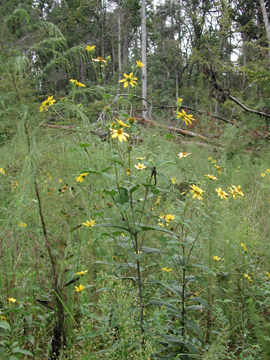
Photo 1. H. resinosus
Photo 2. H. resinosusseed heads
Photo 3. H. resinosusflower
Photo 4. H. arogphyllus
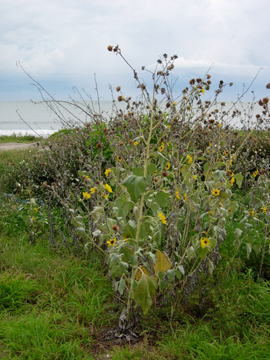
Photo 5. H. arogphyllus
2006 Collection Trip to Southeastern Nebraska and Southwestern Iowa
On September 11th, 2006, Jeffrey D. Carstens (USDA-ARS North Central Regional Plant Introduction Station) and Robert L. Henrickson (photo 1) (Nebraska Statewide Arboretum) met in Richardson Co., Nebraska to collect native woody ornamentals. Quercus prinoides(dwarf chinkapin oak) was one species targeted for collection. An extremely large, secluded population (300 + plants) consisting of very morphologically diverse plants with many acorns was located. This collection (Ames 27352) was made at an elevation of approximately 330m. Characteristics of plant habit, leaf shape/size, acorn shape/size, and powdery mildew resistance were extremely variable (photo 2). This population was growing among a very nice population of Liatris aspera(rough blazing star) (photo 3). Dwarf chinkapin oak is being widely planted in wildlife habitats and ornamental landscapes because of its compact/shrubby growth habit and also for its ability to produce acorns at a very young age (approximately 3 years).
Other collections were made at Indian Cave State Park in Nebraska and Lake of Three Fires State Park in Iowa. Species collected included Cornus drummondii(rough-leaved dogwood) (photo 4), Staphylea trifolia(bladdernut), Quercus muehlenbergii(chinkapin oak), and Fraxinus americana(white ash). Surprisingly, a large population of Viburnum prunifolium(black-haw viburnum) (photo 5) was producing fruit at Lake of Three Fires State Park. A very large specimen (photo 6) reaching 25' in height was found at this location.
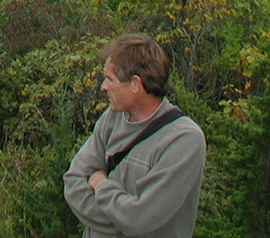
Photo 1. Robert Hendrickson
Photo 2. Ames 27352
Photo 3. Liastris aspera
Photo 4. Cornus drummondii
Photo 5. Viburnum prunifolium
Photo 6. Large specimen of Viburnum prunifolium
Plant Genome Outreach to Native Americans 2006
The NCRPIS hosted and assisted in providing outreach educational experiences for six Native American student interns during summer of 2006, in collaboration with Drs. Carolyn Lawrence and Volker Brendel. The project was funded by NSF supplemental grant entitled "PlantGDB - Plant Genome Database and Analysis Tools (Outreach Supplemental Request)," number 0321600, held by Dr. Brendel. The students learned about the principles of plant genetic resource conservation, maize molecular genetic techniques, and bioinformatic methods. They posted the results of their molecular genetic research alongside cultural practices and information related to maize on an outstanding website created by the students which can be found at:
http://www.lawrencelab.org/Outreach/2006/home.html
This is the first of a five-year summer program.
| << Previous 1 [2] |




